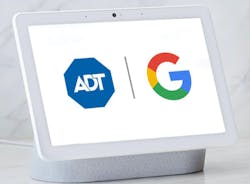ADT-Google partnership begins to bear fruit
In the summer of 2020, ADT stunned the industry when it announced that tech giant Google had invested $450 million and acquired a 6.6% stake in the home security stalwart. The move came at a time when the market still did not know what to make of the increasing encroachment of do-it-yourself solutions on professionally installed alarm systems.
Fast-forward nearly two years and it is clear that DIY offerings have not only carved out their own niche in the industry but have also become a complementary offering, in many ways, to the traditional home security market. Still, many questions remained as to what innovations Google would bring to bear on ADT in terms of their product roadmap. The company had already disrupted the smart home market with its acquisition of smart thermostat maker Nest a year earlier, and industry insiders wondered if ADT would begin installing these types of DIY technologies into the homes of their existing customer base.
Although these predictions have not fully materialized yet, many residential integrators – including ADT – are now seeing DIYDuring an investor press conference on Tuesday, Michael Drory, VP of Strategic Initiatives at ADT, discussed how the partnership between the two will serve as a catalyst for accelerating for their growth.
“This relationship is different; there is nothing like it in the industry, and frankly, there is nothing like it in ADT’s history,” Drory told attendees during the virtual event.
Specifically, Drory said that ADT and Google are committed to the co-development of solutions that leverage the strengths of both brands and that the partnership extends well-beyond financial investment.
“Both ADT and Google have dedicated teams of engineers, product specialists and go-to-market leaders focused on making this partnership a success,” Drory added.
According to Drory, they only intend to expand their solution set with offerings that can be bundled at the point of sale and upsold over the life of the customer. For example, the companies recently collaborated on a new video doorbell that is seeing strong adoption in the market, which is expected to serve as an anchor for their full suite of smart home products with a full Nest portfolio integration that is expected to follow later this year.
“The team – our team and the Google teams – are really excited about the partnership and leaning forward with the products that work well with ADT,” said Keith Holmes, EVP and Chief Revenue Officer for ADT. “From a marketing perspective, we are going to spend 50% of our marketing from a Google perspective this year. We are really getting behind the partnership, we’re really leaning in and making sure that we can educate our customers around what those use-cases mean for them, and how we can help them leverage the products and services to really connect and protect what matters most.”
Additionally, Drory said they are also in the process of developing a proprietary ADT software platform (ADT Plus) and that Google engineers are simultaneously working to ensure that the integration of their products remain seamless. “In the near-term, this will include joint pursuits in life safety, mobile and aging-in-place with longer term optionality around solar, energy and entertainment,” Drory explained.
The companies are also jointly working on an alarm verification solution that leverages Google video and ADT analytics to reduce false alarm and improve response times.
“On the product side, 2021 was really a design and development year, to make sure that all the integrations were built between the Google products and our own command and control platform, and our new ADT Plus platform,” added Don Young, EVP andLeveraging the Brands
As part of their commitment to the partnership, Drory said that people can expect to see the Google brand alongside ADT in both their sales and distribution channels, adding that they have already introduced new uniforms for their field techs with a new fleet truck design that will follow soon.
“ADT and Google are very much complementary in the way our capabilities line up,” he explained. “If you think about an overly simplistic customer segmentation, ADT is thriving off the professional monitoring premium customer in our category. These folks want a more white-glove sales, install and service experience – one that ADT delivers. Our customer acquisition approach focuses on traditional phone, field and dealer channels. Google is very much the opposite. As a historically DIY-centric business, Google customers tend to enter our category through retail and digital channels. These are channels that represent an untapped opportunity for ADT.”
While Google products have historically been more attractive to ADT customers as standalone devices, Drory said their addition to the overall portfolio is helping the company lean into smart home bundles and subsequently sell larger solutions.
“For example, in the past, we would have sold an ADT doorbell as a standalone device; now, we are actively selling in-home bundles that pair a Google doorbell with a hub display and a Google Mini,” he explained. “The Mini serves as the chime, and the hub provides customers with an integrated view of their front porch from their kitchen counter.”
ADT executives also continue to emphasize the long-term nature of the partnership and noted that they are really only scratching the service of what they can accomplish together.
“In many respects, we are still building the foundation for many years to come,” said ADT President and CEO Jim DeVries. “We feel terrific about the partnership overall. Importantly, there is a strong cultural match. We feel the same customer focus from ourADT Solar
Following in the footsteps of rival Vivint, ADT late last year acquired residential solar panel installation firm Sunpro Solar in a deal that would enable the company to enter the burgeoning residential energy market.
According to DeVries, the new ADT Solar is “off to a great start” and everything they outlined in their presentation following the acquisition is now coming to fruition.
“We’re early in the process,” he said. “We’re out of the gates well. We’re testing and learning in a number of ADT markets,” DeVries said. “It’s early – we’ve only owned this asset for in the neighborhood of 90 days, so we’re still early in the process – but lead flow is going well, and we continue to be optimistic.”
Marc Jones, VP of ADT Solar, added that the synergies between ADT and Sunpro are strong and that they two companies are coming together well.
“I would say 90 days later, we are even more excited with the different opportunities that are coming online with retail, home builders, the dealer network, and existing customers,” he added. “We’ve seen close ratios increase significantly, and customers are stickier, more likely to keep an appointment, and lower cancellation rates. Across the board, we are seeing tremendous lift from ADT.”
3G Sunset
With AT&T beginning to phase out its 3G network as of last week, there has been a great deal of concern within the industry about migrating customer accounts to updated 4G and 5G-compatible radios. And while the FCC brokered a temporary workaround that will enable integrators to leverage the T-Mobile network for now, this will only provide integrators with a few months to make the migration.
However, ADT executives say that despite the amount of additional work, the company has largely been able to make these conversions for the bulk of their accounts.
“We were fortunate to leverage our size and scale to avoid any kind of supply chain challenges. It has never been a problem for us to go in and get our hands on the equipment necessary to upgrade our customers,” explained Young. “We have a handful of them left. We’ve got the resources already in place. It’s really just down to the last meter to try to actually get in touch with the customers, allow us to go ahead and get those upgrades done, and get them on track. In the meantime, we have not seen any customers actually have their 3G radios turned off yet, so we’re just kind of playing that out as time goes by.”
About the Author
Joel Griffin
Editor-in-Chief, SecurityInfoWatch.com
Joel Griffin is the Editor-in-Chief of SecurityInfoWatch.com, a business-to-business news website published by Endeavor Business Media that covers all aspects of the physical security industry. Joel has covered the security industry since May 2008 when he first joined the site as assistant editor. Prior to SecurityInfoWatch, Joel worked as a staff reporter for two years at the Newton Citizen, a daily newspaper located in the suburban Atlanta city of Covington, Ga.
Paul Rothman
Editor-in-Chief/Security Business
Paul Rothman is Editor-in-Chief of Security Business magazine. Email him your comments and questions at [email protected]. Access the current issue, full archives and apply for a free subscription at www.securitybusinessmag.com.





